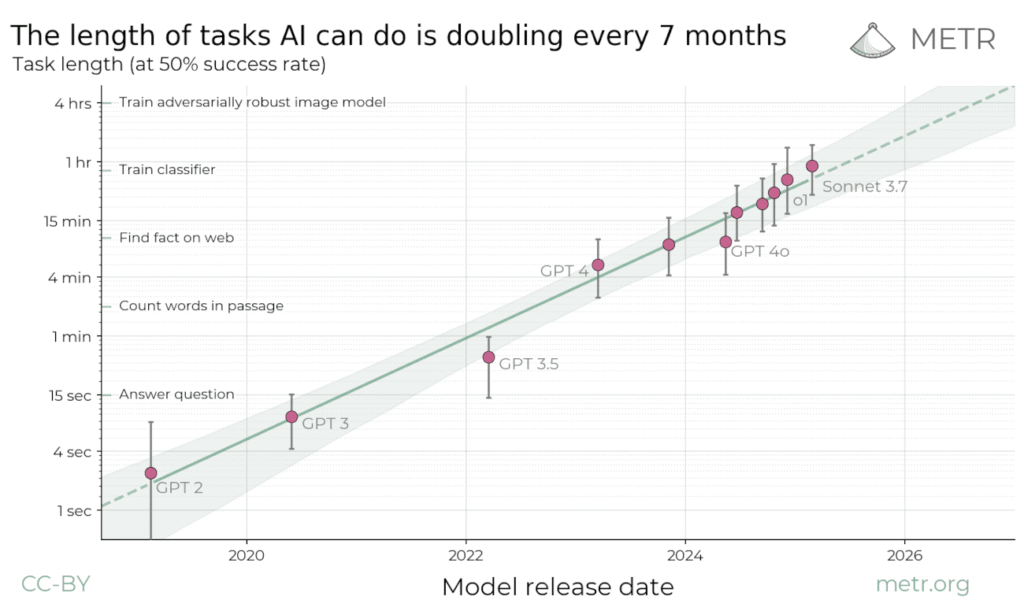The AI Seven-Month Rule: Why Your Business Timeline Just Got Shorter
There’s a pattern emerging in artificial intelligence that should fundamentally change how you think about planning, hiring, and the future of work. It’s called the seven-month rule, and it’s quietly reshaping entire industries while most business leaders aren’t even aware it exists.
Here’s what it means: every seven months, AI doubles its ability to complete complex, expert-level tasks that currently take humans significant time to finish. Not improves by 10% or 20%. Doubles.

Think about that for a moment. If an AI system can currently handle work that takes a skilled professional two hours, in seven months it will tackle four-hour projects. Seven months after that, it’s completing full-day assignments. By the following cycle, it’s handling multi-day projects that would normally require a small team.
This isn’t speculation or hype. Researchers have been tracking this exponential progression across various domains, measuring AI performance against the time it takes expert humans to complete the same work. The consistency is striking and the implications are staggering.
Why This Changes Everything for Business Leaders
Most business planning operates on annual cycles. Budget reviews, strategic planning, workforce development and these typically unfold over 12 to 18-month horizons. But if AI capabilities are doubling every seven months, your carefully crafted annual strategy might be obsolete before the ink dries.
Consider a marketing agency that currently uses AI to handle basic content research, tasks that might save junior employees an hour here and there. Under the seven-month rule, that same AI will soon be conducting comprehensive competitive analyses, developing full campaign strategies, and potentially managing entire client relationships from start to finish.
The timeline isn’t theoretical. It’s mathematical.
The Compound Effect Nobody’s Talking About
What makes this particularly powerful is the compound nature of these improvements. This isn’t linear growth where AI gets slightly better at existing tasks. Each doubling cycle opens entirely new categories of work that become automatable.
Take financial analysis as an example. An AI might start by automating simple data entry and basic calculations. Seven months later, it’s generating preliminary reports. Another seven months, and it’s conducting complex market analyses. Soon after, it’s providing strategic investment recommendations that rival senior analysts.
The pattern holds across industries. Legal research transforms into brief writing, then case strategy development. Medical diagnosis assistance evolves into treatment planning, then personalized care coordination. What begins as tool assistance becomes independent capability surprisingly fast.
The Invisible Acceleration
The challenge for business leaders is that this progression often feels gradual day-to-day, even as it’s exponential month-to-month. It’s like compound interest in reverse: the changes seem small initially, then suddenly become overwhelming.
Many organizations are experiencing this as a creeping sense that their workflows could be more efficient, their teams more productive, their costs lower. They’re not wrong. They’re witnessing the early stages of exponential capability growth, but most don’t recognize it for what it is.
The companies that understand the seven-month rule are making different decisions. They’re not just asking “What can AI do for us today?” They’re asking “What will AI be capable of by the end of next year, and how do we prepare for that reality now?”
Planning for Acceleration
Smart business leaders are already adapting their approach. Instead of viewing AI as a static tool that improves incrementally, they’re building strategies around accelerating capabilities.
This means rethinking workforce development. Rather than training people to compete with AI, forward-thinking companies are focusing on skills that complement rapidly evolving AI capabilities. They’re identifying which roles will likely be automated within the next few cycles and which will become more valuable as AI handles routine work.
It also means approaching vendor relationships and technology investments differently. Solutions that seem cutting-edge today may be table stakes in less than two years. The question becomes not just “Does this solve our current problem?” but “Will this scale with AI advancement or become a limiting factor?”
Your Next Seven Months
If you accept the seven-month rule as valid (and the research suggests you should) then your planning horizon just shifted dramatically. AI will transform your industry, so you need to make sure your company is leading that transformation instead of scrambling to catch up.
Start by identifying the most time-intensive, expert-level work in your organization. Map out what happens if AI can handle those tasks in 7, 14, or 21 months. Not perfectly, but well enough to be useful. Then work backward to figure out what you need to start doing today.
Want to stay ahead of rapid AI developments that could transform your industry? Let’s talk about building an AI strategy that anticipates exponential change rather than reacting to it. Get in touch to explore how your organization can leverage the seven-month rule for competitive advantage.







